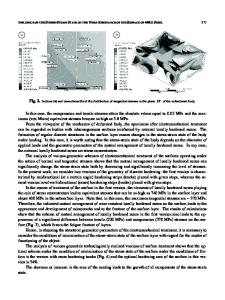Physicochemical Properties of Carbonitrided 40Kh Steel
- PDF / 735,040 Bytes
- 6 Pages / 594 x 792 pts Page_size
- 103 Downloads / 381 Views
PHYSICOCHEMICAL PROPERTIES OF CARBONITRIDED 40Kh STEEL M. S. Stechyshyn,1, 2 V. P. Oleksandrenko,1 А. V. Martynyuk,1 М. М. Luk’yanyuk,1 М. Ya. Dovzhyk,3 and V. О. Herasymenko3 We present the results of investigations of the influence of hydrogen-free carbonitriding in glow discharge on the physicochemical characteristics of the hardened layer of 40Kh steel depending on the content of propane and the pressure of gas atmosphere. We consider three versions of saturation: carbon + nitrogen, nitrogen + carbon, and simultaneous saturation with nitrogen and carbon. The analysis of the obtained results reveals the highest efficiency of hardening of the surface of 40Kh steel for the third version of saturation. Keywords: carbonitriding, microhardness, structure.
Introduction Carbonitriding in glow discharge is the process of simultaneous saturation of the metal surface with nitrogen and carbon at low temperatures (from 500 to 600°C). Some results of investigations of this process were presented in [1, 2]. In these works, the authors studied influence of carbon on the structure and properties of nitrided layers in the course of hardening in ammonia plasma with additions of carbon-containing gases. Thus, in particular, a layer with developed carbonitrided surface zone is formed in the process of nitriding in ammonia plasma with propane admixtures. In the region of internal nitriding, this zone contains a carbonitride network formed on the boundaries of austenite grains. The introduction of propane into ammonia plasma decreases the rate of formation of the zone of internal nitriding. The dependence of thickness of the [ Fe 2–3 (NC)] zone on the concentration of carburizing gas, e.g., propane, has an extremal character. The maximal development of the carbonitride zone is realized for the propane contents of the mixture from the range 8–12%. In this case, its thickness is 1.5 times larger than the depth of the nitride zone obtained by nitriding in ammonia plasmas. For propane contents of ∼ 40%, the process of growth of the nitrided layer is completely inhibited, most likely as a result of formation of a carbonitride (or carbographite) film on the surface. The influence of the composition of saturating atmosphere on the wear resistance of 38KhMYuА steel was also investigated. Thus, we studied steel nitrided at 520 and 650°C for 1.3 h in ammonia and in mixtures of ammonia with propane and argon. Moreover, processes were combined according to the following two-stage scheme (with separated stages): – in the first stage (1.5 h), a zone of internal nitriding is formed on the steel surface under the conditions of treatment in an ammonia-argon plasma (10% ammonia + 90% argon); 1 2 3
Khmelnytskyi National University, Khmelnytskyi, Ukraine. Corresponding author; e-mail: [email protected].
Sumy National Agricultural University, Sumy, Ukraine.
Translated from Fizyko-Khimichna Mekhanika Materialiv, Vol. 56, No. 3, pp. 76–80, May–June, 2020. Original article submitted January 27, 2020. 1068-820X/20/5603–0369
© 2020
Springer Science+Business
Data Loading...











